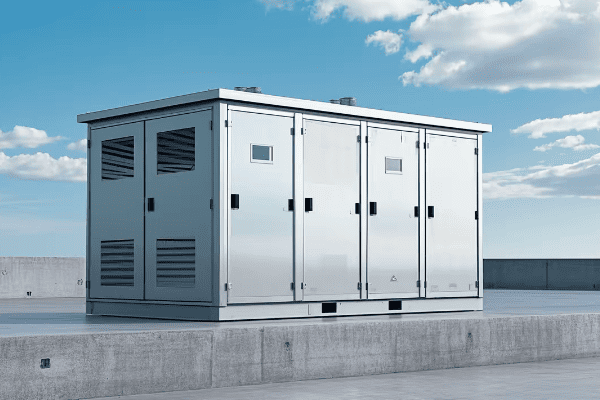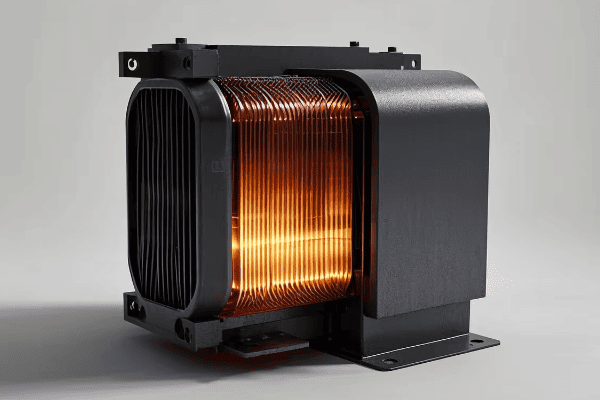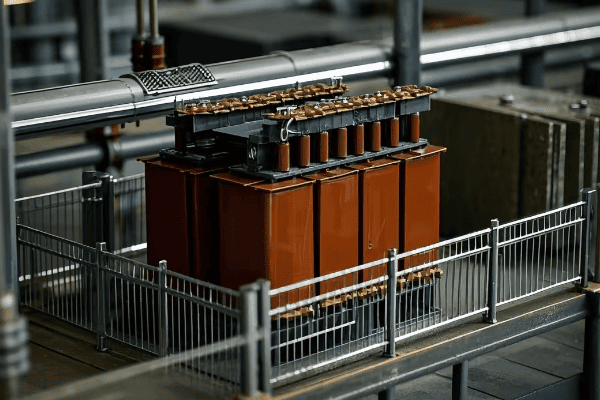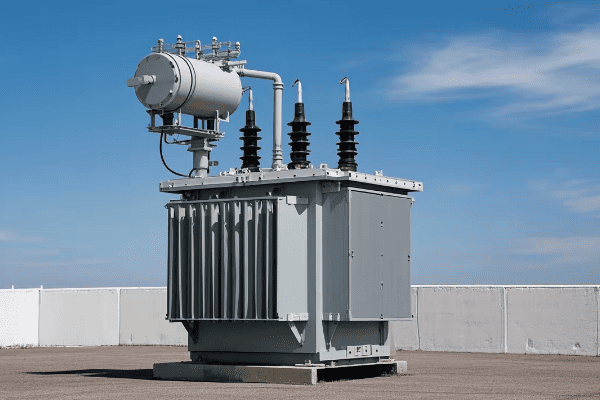Understanding Transformer Surge Current: Causes and Simple Testing Methods Explained
Have you ever wondered why your power flickers when a large electrical system starts up? The answer might lie in a phenomenon called transformer surge current.
Transformer surge current is a temporary, high-magnitude current that occurs when a transformer is energized. It can be 6-8 times the rated current, potentially causing power quality issues and equipment stress. Understanding and managing surge current is crucial for maintaining reliable power systems.

As someone who’s spent years working with power systems, I’ve seen firsthand the impact of surge currents. Let’s dive into this fascinating aspect of transformer operation and explore why it matters for everyone in the electrical industry.
What Exactly is Transformer Surge Current and Why Does it Matter?
Imagine turning on a massive engine. The initial roar is much louder than its normal running sound. That’s similar to what happens with transformer surge current.
Transformer surge current, also called inrush current, is a large, temporary current that flows when a transformer is first energized. It typically lasts for a few cycles to several seconds and can be 6-8 times the transformer’s rated current. This matters because it can cause power fluctuations, trigger protective devices, and potentially damage equipment.

Let’s break down the key aspects of transformer surge current:
Understanding the Surge
-
Cause of the Surge
- Sudden magnetization of the transformer core
- Residual magnetism in the core
- Voltage phase angle at the moment of energization
-
Duration
- Typically lasts for a few cycles to several seconds
- Decays exponentially over time
-
Magnitude
- Can reach 6-8 times the rated current
- Varies based on transformer size and design
-
Frequency Components
- Contains both AC and DC components
- Rich in harmonics, especially second and third
Here’s a table summarizing the characteristics of surge current:
| Characteristic | Normal Current | Surge Current |
|---|---|---|
| Magnitude | 1x rated | 6-8x rated |
| Duration | Continuous | Few cycles to seconds |
| Waveform | Sinusoidal | Distorted, with harmonics |
| DC Component | None | Significant |
I remember a case where a large industrial client was experiencing frequent circuit breaker trips during transformer energization. We discovered that the surge current was exceeding the breaker’s instantaneous trip setting. By adjusting the protection settings and implementing controlled switching, we resolved the issue, saving the client significant downtime and frustration.
Understanding surge current is crucial for:
- Proper transformer design
- Accurate protection system settings
- Preventing unnecessary outages
- Ensuring power quality for sensitive loads
In my experience, many electrical engineers underestimate the impact of surge current. It’s not just a theoretical concept – it has real-world implications for system reliability and equipment longevity.
How Does Core Saturation Contribute to Surge Current in Transformers?
Picture a sponge that’s already wet trying to absorb more water. It can’t take much more, right? That’s similar to what happens with core saturation in transformers.
Core saturation occurs when the magnetic flux in a transformer’s core exceeds its capacity. This leads to a dramatic increase in magnetizing current, contributing significantly to surge current. Saturation can cause the surge current to reach up to 10 times the normal magnetizing current.

Let’s dive deeper into how core saturation affects surge current:
The Saturation-Surge Connection
-
Magnetic Flux and Core Material
- Transformer cores are designed to operate below saturation
- Sudden energization can push the core into saturation
-
Residual Magnetism
- Leftover magnetism from previous operation
- Can either increase or decrease saturation effects
-
Voltage Angle at Energization
- Worst-case scenario: energizing at voltage zero-crossing
- Can lead to maximum core saturation
Here’s a table showing the relationship between core saturation and surge current:
| Core State | Magnetizing Current | Surge Current Magnitude |
|---|---|---|
| Unsaturated | Normal (1x) | Moderate (2-4x rated) |
| Partially Saturated | Increased (2-5x) | High (4-6x rated) |
| Fully Saturated | Very High (5-10x) | Extreme (6-10x rated) |
I once worked on a project where we were commissioning a new substation. During the first energization of a large power transformer, we experienced unexpectedly high surge currents that tripped the main breaker. After investigation, we found that the core had a high level of residual magnetism from factory testing. By implementing a demagnetization procedure before energization, we significantly reduced the surge current magnitude.
To understand core saturation and its impact, consider these factors:
- Core material properties (e.g., silicon steel vs. amorphous metal)
- Design of the magnetic circuit
- Operating flux density
- Presence of DC offset in the system
It’s important to note that while core saturation is a major contributor to surge current, it’s not the only factor. System impedance, switching angle, and transformer design all play roles in determining the final surge current magnitude.
In my years of experience, I’ve found that many engineers focus solely on the electrical aspects of transformers, often overlooking the crucial role of magnetic design in surge current behavior. A holistic understanding of both electrical and magnetic phenomena is essential for effective transformer management.
What Are the Potential Risks of Excessive Surge Current in Transformers?
Imagine a river suddenly flooding its banks. The damage can be extensive and far-reaching. Excessive surge current in transformers can have similar wide-ranging impacts on your electrical system.
Excessive surge current can lead to numerous risks, including mechanical stress on windings, insulation degradation, false tripping of protection devices, and power quality issues. In severe cases, it can cause transformer failure, system instability, and even widespread power outages.

Let’s explore the potential risks in detail:
Understanding the Dangers
-
Mechanical Stress on Windings
- High currents create strong electromagnetic forces
- Can lead to winding deformation or displacement
-
Thermal Stress
- Sudden current spikes generate heat
- Accelerates insulation aging
-
Insulation Degradation
- Repeated stress weakens insulation over time
- Increases risk of internal faults
-
Protection System Malfunction
- False tripping of overcurrent relays
- Unnecessary system outages
-
Power Quality Issues
- Voltage dips during surge events
- Harmonics introduction into the system
Here’s a table summarizing the risks and their potential consequences:
| Risk | Immediate Effect | Long-term Consequence |
|---|---|---|
| Mechanical Stress | Winding movement | Reduced transformer life |
| Thermal Stress | Localized heating | Accelerated aging |
| Insulation Degradation | Partial discharges | Eventual insulation failure |
| Protection Malfunction | Nuisance tripping | Reduced system reliability |
| Power Quality Issues | Voltage fluctuations | Equipment malfunction |
I recall a case where a client experienced repeated transformer failures in a critical industrial process. Upon investigation, we discovered that frequent energization due to process requirements was causing cumulative damage from surge currents. By implementing controlled switching and adjusting the process schedule, we extended the transformer life significantly and improved overall system reliability.
When assessing the risks of surge current, consider these factors:
- Transformer size and design
- Frequency of energization events
- System fault level and impedance
- Criticality of the load being served
It’s crucial to note that while modern transformers are designed to withstand normal surge currents, repeated or excessive events can still cause cumulative damage. Regular monitoring and proper management of energization procedures are key to mitigating these risks.
In my experience, many organizations underestimate the long-term impact of surge currents, focusing only on immediate failures. A proactive approach to surge current management can lead to significant improvements in system reliability and asset longevity.
How Can You Measure Transformer Surge Current Using Simple Methods?
Ever tried to catch a lightning bolt on camera? Measuring transformer surge current can be just as tricky, but don’t worry – I’ve got some simple methods that can help.
Transformer surge current can be measured using current transformers (CTs) connected to oscilloscopes or power quality analyzers. For simpler setups, you can use peak-reading ammeters or even protection relay event records. The key is to capture the initial peak and decay pattern of the surge current.

Let’s explore some practical methods for measuring surge current:
Simple Measurement Techniques
-
Oscilloscope Method
- Use a CT to step down the current
- Connect CT output to oscilloscope
- Trigger on the energization event
-
Power Quality Analyzer
- Many modern analyzers have inrush current functions
- Can capture waveforms and provide detailed analysis
-
Peak-Reading Ammeter
- Simple but effective for magnitude measurement
- Won’t provide waveform details
-
Protection Relay Event Records
- Many digital relays can record inrush events
- Check relay manuals for this functionality
Here’s a comparison table of these methods:
| Method | Accuracy | Waveform Capture | Ease of Use | Cost |
|---|---|---|---|---|
| Oscilloscope | High | Yes | Moderate | High |
| Power Quality Analyzer | High | Yes | Easy | High |
| Peak-Reading Ammeter | Moderate | No | Very Easy | Low |
| Protection Relay Records | Moderate | Limited | Easy | Low (if already installed) |
I remember a project where we needed to measure surge currents on a large number of distribution transformers. Budget constraints meant we couldn’t use expensive equipment on every unit. We developed a hybrid approach: using a high-end power quality analyzer for detailed measurements on representative units, and simple peak-reading ammeters for quick checks on the rest. This allowed us to gather comprehensive data while staying within budget.
When measuring surge current, keep these tips in mind:
- Ensure your measurement equipment can handle the expected peak currents
- Pay attention to the CT ratio and burden
- Use appropriate safety measures – these are high-current measurements!
- Try to capture multiple energization events for a better understanding
It’s important to note that while these methods can provide valuable data, interpreting the results requires some expertise. The shape of the inrush current waveform, its decay time, and its harmonic content all provide important information about the transformer and the system it’s connected to.
In my years of field experience, I’ve found that even simple measurements can provide crucial insights. Don’t be discouraged if you don’t have access to high-end equipment – with careful setup and interpretation, even basic tools can yield valuable results.
What Factors Influence the Magnitude of Transformer Surge Current?
Have you ever wondered why some transformers seem to handle energization smoothly while others cause the lights to flicker? The answer lies in the factors that influence surge current magnitude.
The magnitude of transformer surge current is influenced by several factors, including the point-on-wave of energization, residual flux in the core, system impedance, and transformer design characteristics. Understanding these factors is crucial for predicting and managing surge currents effectively.

Let’s dive into the key factors that affect surge current magnitude:
Critical Influencing Factors
-
Point-on-Wave of Energization
- Timing of switch closure relative to voltage waveform
- Worst case: closing at voltage zero-crossing
-
Residual Flux in the Core
- Magnetism left in the core from previous operation
- Can either add to or subtract from the surge current
-
System Impedance
- Lower impedance leads to higher surge currents
- Includes source impedance and line impedance
-
Transformer Design
- Core material and design (e.g., shell-type vs. core-type)
- Winding configuration and impedance
Here’s a table summarizing these factors and their impacts:
| Factor | Low Impact Scenario | High Impact Scenario |
|---|---|---|
| Point-on-Wave | Energized at peak voltage | Energized at zero voltage |
| Residual Flux | Opposing incoming flux | Aiding incoming flux |
| System Impedance | High impedance source | Low impedance source |
| Transformer Design | High impedance, modern core | Low impedance, traditional core |
I recall a case where we were troubleshooting excessive surge currents in a industrial plant. Initial assumptions pointed to the transformers, but after careful analysis, we discovered that recent system upgrades had significantly reduced the source impedance. This lower impedance was allowing much higher surge currents. By adjusting the switching strategy and adding series reactors, we were able to bring the surge currents back to acceptable levels.
When analyzing surge current factors, consider these points:
- The worst-case scenario often involves a combination of factors
- System changes can have unexpected impacts on surge current behavior
- Modern transformers often have design features to mitigate surge currents
- Operational practices can significantly influence surge current magnitude
It’s crucial to understand that while some factors (like transformer design) are fixed, others (like point-on-wave switching) can be controlled. This gives us opportunities to manage surge currents even in existing systems.
In my experience, many engineers focus solely on the transformer when dealing with surge current issues. However, a holistic approach considering all system factors often leads to more effective and economical solutions. Remember, the transformer is just one part of a larger electrical ecosystem.
How Can You Mitigate the Effects of Surge Current in Power Transformers?
Dealing with transformer surge current can feel like trying to tame a wild beast. But don’t worry – I’ve got some proven strategies to help you keep this electrical monster under control.
Mitigating surge current effects involves a combination of design choices, operational strategies, and additional equipment. Key approaches include controlled switching, pre-insertion resistors, neutral earthing resistors, and proper transformer design. The goal is to reduce the peak magnitude and duration of the surge current.

Let’s explore some effective mitigation strategies:
Proven Mitigation Techniques
-
Controlled Switching
- Energize at optimal point-on-wave
- Requires specialized switching devices
-
Pre-insertion Resistors
- Temporarily insert resistance during energization
- Limits initial current surge
-
Neutral Earthing Resistors
- Reduces zero-sequence inrush current
- Particularly effective for delta-wye transformers
-
Transformer Design Optimization
- Use of low-loss core materials
- Proper selection of core flux density
-
Soft-start Techniques
- Gradual voltage ramp-up
- Often used in motor-generator sets
Here’s a comparison table of these mitigation methods:
| Method | Effectiveness | Cost | Complexity | Applicability |
|---|---|---|---|---|
| Controlled Switching | High | Moderate | Moderate | Wide |
| Pre-insertion Resistors | High | Moderate | Low | Specific cases |
| Neutral Earthing Resistors | Moderate | Low | Low | Grounded systems |
| Design Optimization | Moderate | Varies | High | New transformers |
| Soft-start Techniques | High | High | High | Special applications |
I remember a project where we were dealing with nuisance tripping in a critical power system due to surge currents. After analyzing the system, we implemented a combination of controlled switching and pre-insertion resistors. The results were dramatic – we reduced the peak surge current by over 50% and completely eliminated the tripping issues. The client was thrilled with the improved reliability.
When implementing surge current mitigation, keep these points in mind:
- No single solution fits all situations – often a combination is best
- Consider both the technical and economic aspects of each solution
- Some methods (like controlled switching) can have benefits beyond surge reduction
- Regular system studies are crucial as network changes can affect surge behavior
It’s important to note that while mitigation techniques can significantly reduce surge currents, they can’t eliminate them entirely. The goal is to bring the surge current within acceptable limits for your specific system and equipment.
In my years of experience, I’ve found that a proactive approach to surge current management can save significant costs in the long run. It’s not just about preventing failures – it’s about optimizing system performance, extending equipment life, and improving overall reliability.
One case that stands out in my memory involved a large data center. They were experiencing frequent issues with their UPS systems due to transformer inrush currents. We implemented a comprehensive mitigation strategy that included:
- Replacing older transformers with modern, low-inrush designs
- Installing controlled switching devices on critical feeders
- Implementing a staged energization procedure for large loads
The results were impressive. Not only did we eliminate the UPS issues, but we also saw a marked improvement in overall power quality. The client reported a 30% reduction in their annual maintenance costs for power equipment.
When considering surge current mitigation, it’s crucial to take a system-wide approach. Here’s a step-by-step strategy I often recommend:
-
Conduct a System Study
- Analyze existing surge current levels
- Identify critical points in the network
-
Set Clear Objectives
- Define acceptable surge current limits
- Consider both equipment protection and operational needs
-
Evaluate Mitigation Options
- Consider technical feasibility and cost-effectiveness
- Look for solutions that offer multiple benefits
-
Implement in Phases
- Start with the most critical or problematic areas
- Monitor and adjust as you go
-
Regular Review and Adjustment
- Power systems evolve – your mitigation strategy should too
- Conduct periodic reviews to ensure ongoing effectiveness
Remember, managing surge currents is not a one-time task. It’s an ongoing process that requires attention and adaptation as your power system changes and grows.
Conclusion
Understanding and managing transformer surge current is crucial for maintaining reliable and efficient power systems. By considering the causes, risks, measurement techniques, influencing factors, and mitigation strategies, we can effectively control this phenomenon and ensure the longevity of our electrical infrastructure.
Free CHBEB Transformer Catalog Download
Get the full range of CHBEB transformers in one catalog.
Includes oil-immersed, dry-type, pad-mounted, and custom solutions.
Quick Message
Request A free quote
We'd like to work with you
- +86 15558785111
- [email protected]
- +86 15558785111
What We Do
CHINA BEI ER BIAN (CHBEB) GROUP, with 218 million in registered capital, originated from Beijing Beierbian Transformer Group. Headquartered in Beijing for R&D, it operates major production bases in Nanjing and Yueqing, producing high-quality products.
Latest Product
address
BeiJing
No 3,RongJing East Road,BeiJing Economic Technological Development Area,BeiJing,China
JiangSu
No 7️Xiangfeng Road,Jiangning,NanJing,JiangSu,China
WenZhou
No.211, Wei 16 Road, Industrial Zone, Yueqing, Wenzhou, Zhejiang, China.
XiangYang Industrial Zone ,YueQing,WenZhou,ZheJiang,China
contact us
- [email protected]
- +86 13057780111
- +86 13057780111
- +86 15558785111
Copyright © Bei Er Bian Group


